UC Blogs
Honey Bees and Extinction
"Would the extinction of honey bees lead directly to the extinction of humans?" That's a recent question posed on Quora, where folks can ask...
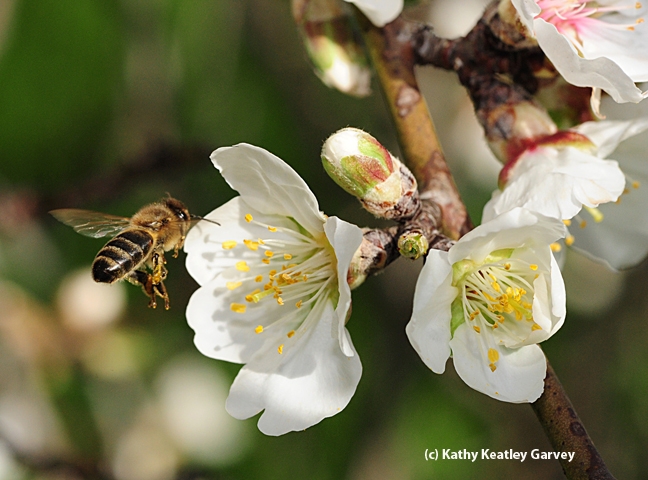
A honey bee heading toward almond blossoms. (Photo by Kathy Keatley Garvey)
Wicked Itch
Contact Dermatitis (CD) is a skin inflammation that occurs when substances touching your skin cause irritation or an allergic reaction. Airborne substances (ragweed, insecticide sprays) can also cause CD. The resulting red, itchy rash isn't contagious or life-threatening, but it can be very uncomfortable. Successful treatment consists of identifying the culprit and avoiding it so that the rash can resolve in two to four weeks.
Irritant CD is a substance that damages your skin's outer protective layer; often on hands, fingers, face (plants, soap, chemicals, cosmetics), resulting in non-allergic, inflammatory skin reactions or rash. Not everyone will develop an allergy, but no one is safe from an irritant. Allergic CD (ACD): a substance to which you're sensitive (allergen) triggers an immune reaction in your skin (plants, natural rubber, metals, jewelry, perfume, cosmetics, hair dyes). The first encounter sensitizes the allergic individual, resulting in the production of white blood cells that recognize the allergen. Usually, the second and subsequent encounters with the allergen stimulate the allergic response.
Photoallergic/Photosensitization CD is a substance that causes ACD only after you apply a substance (topical or ingested) and sunlight then strikes your skin (sunscreens, ointments with NSAIDs, oral drugs such as hydrochlorothiazide/water pill
Four days after pruning a Honeysuckle vine (Lonicera spp.) with no gloves, in a sleeveless shirt, I had a rash on elbows/inner arms that soon spread down the sides of torso, to lower back and butt. Another four days later, my thighs and legs were rashy. Elbows and thighs felt like alligator skin. Thankfully, not on face or other sensitive areas.
"Insane" itching with no relief. I washed with Tecnu, Dr. Bonner, dish detergent (couldn't find oatmeal soap without perfume). BUT soap irritates, so a simple, cool shower is better. I applied cold compress, calamine, anti-itch gel, hydrocortisone cream, Triamcinolone cream (left over from a poison oak bout), aloe, tea tree oil, calendula gel, banana peel, cucumber. Nothing helped for more than 30 minutes. I took Antihistamines (diphenhydramine) and felt drowsy and tired. A LOT of different antihistamines on the shelf, so I asked the pharmacist which one to use for itching. I did not try onion, rubbing alcohol, white vinegar (with salt or baking soda), cooked oatmeal covered with gauze or saran wrap, blow drying or chlorine (swimming pool).
The only inkling of relief was soaking in Epsom salts, 20-25 minutes, two to three times a day. (A woman at Bed, Bath & Beyond battling poison oak said it was the only thing that helped. I concur). Sometimes I included a handful of natural colloidal oatmeal powder or used it alone. Sometimes I boiled water, dissolved colloidal oatmeal and sponged down. Maybe the wash cloth helped spread the rash, but for a short period I was joyfully relieved during two weeks of hell.
I finally contacted my doctor in Santa Rosa. She indicated: 1) Triamcinolone was a good idea because Hydrocortisone (over-the-counter) is too "weak"; 2) very unlikely to benefit from antibiotics since it's not painful and no pustules; 3) occasionally they might prescribe oral prednisone, especially if the rash is in a wide area, on genitals or face, but this has the disadvantage of causing anxiety/sleeplessness; 4) this is not something for the ER unless you develop shortness of breath or swelling of lips.
She prescribed Triamcinolone. By now, the rash was starting to abate. The itching, though lighter, continued for 1-2 weeks (my skin was really dried out by now). Soaking in the tub remained the most helpful of anything.
This is a stark reminder to always wear gloves in the garden when handling plants or gardening materials. Long sleeves and long pants is good practice, especially if you are allergy-prone or have a compromised immune system. Remember, you can develop allergies later in life. Remember, the rash can take 2-4 weeks to resolve. If you see a rash developing and it alarms you, see your doctor. This was the most convincing argument to save my money and get a Shingles shot--which my doctor has been recommending for four years. Shingles means pustules and nerve pain. This rash was agony enough.
Sources: (1) California Master Gardener Handbook, for sale at http://anrcatalog.ucdavis.edu/GrowingVegetablesFruitsNuts/3382 (2) Mayo Clinic http://www.mayoclinic.com/health/contact-dermatitis/DS00985 (3) Info on"poisonous" (including toxicity level) and "safe" plants: http://ucanr.edu/sites/poisonous_safe_plants/files/154528.pdf and http://aggie-horticulture.tamu.edu/earthkind/landscape/poisonous-plants-resources/common-poisonous-plants-and-plant-parts/
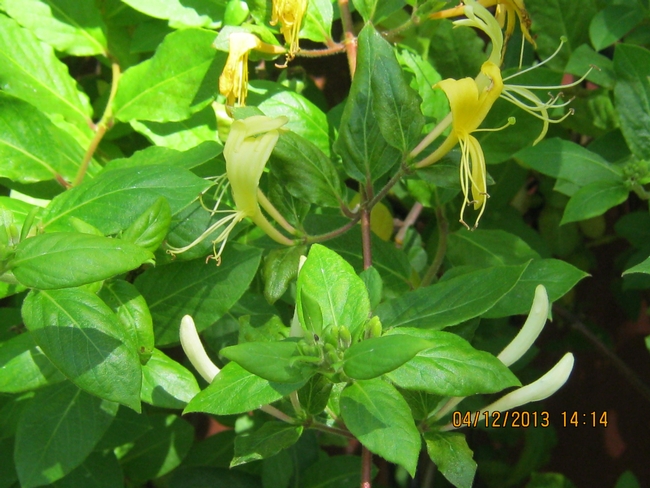
Honeysuckle. (photos by Susan Croissant)
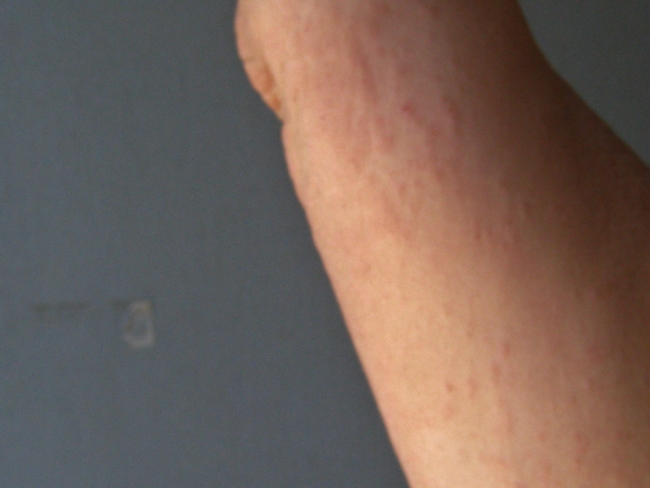
CD on arm.
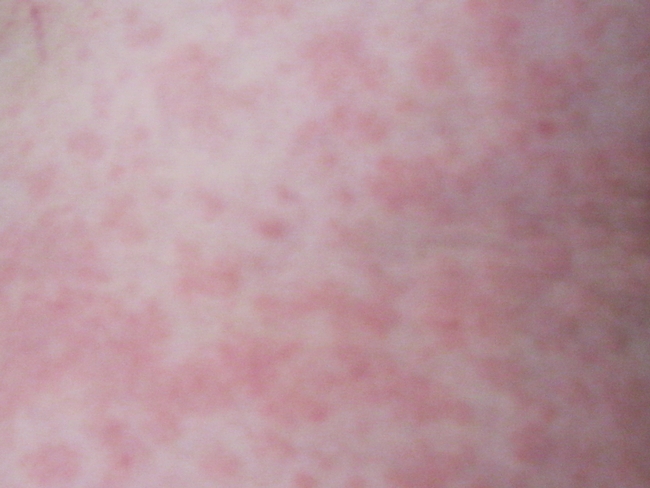
CD on torso.
Project fosters connections between farmers and food buyers
The 100 miles between the agricultural fields that surround Davis, Sacramento and the Sierra Foothhills and the culinarily rich city of San Francisco can seem vast to farmers who lack the connections needed to market their produce to Bay Area buyers.
That gap was bridged this week for a group of 25 small, beginning and ethnic farmers when the Agricultural Sustainability Institute (ASI) at UC Davis and the Sacramento County UC Cooperative Extension hosted a day-long bus tour that began in Sacramento early Tuesday morning. Farmers boarded a bus bound for the Bay Area, where they met wholesale food buyers.
“Many buyers are eager to meet small-scale farmers who can supply the rapidly expanding market for locally grown food,” said David Visher of the Agricultural Sustainability Institute at UC Davis.
Emma Torbert of Cloverleaf Farm was pleased to find that to be true.
“It was nice for farmers to hear how much interest there is in San Francisco,” she said. “It can be nerve-racking to try to sell something to someone you don’t know. This was great, because the tour created an environment to talk about this sort of thing.”
Doors into the Bay Area market have already opened for Emma.
“I’ve had people calling me back already to buy my produce,” she said.
Interest in locally produced food is growing nationwide, according to Gail Feenstra of the UC Sustainable Agriculture Research and Education Program, a program within ASI.
“Food is an important part of our concept of community. People want a relationship with local growers because their food nurtures us. They feed our sense of community and also steward the land in our region. I think people are searching for ways to connect around food because it benefits our personal, economic and environmental health.”
As the group headed west toward their first stop at the San Francisco Wholesale Produce Market to hear from various buyers, Visher and fellow tour organizer Chuck Ingels, a UC Cooperative Extension farm advisor and the interim county director for Sacramento County, shared a food safety/ self audit CD created by UC Cooperative Extension. The project staff also helps farmers create an action plan for marketing their produce and works with them one-on-one to write a profile about their farm.
“We can help growers tell their stories and make good-value propositions to buyers, but it’s really up to these business people to make their own deals,” Visher said.
The institute, Laura Tourte, a UC Cooperative Extension farm advisor for Santa Cruz County, and Santa Clara County Farm Advisor Aziz Baameur will host a second tour Tuesday, Nov. 5. Farmers on Tuesday’s tour will leave for San Francisco from Watsonville at 5:15 a.m. and San Martin 6:15 a.m. The group will visit a wholesale distributor, food hub, distribution/processing facility, grocery store and Stanford dining services, where they will have lunch.
The Small Ethnic Farmer Tour Project is funded by CoBank, a national cooperative bank, and three farm credit associations: Farm Credit West, American AgCredit, and Farm Credit Services of Colusa-Glenn.
To register for the tour out of Watsonville and San Martin call (831) 763-8040 or email cesantacruz@ucdavis.edu. Space is limited. There is a $20 fee to hold a space on the tour. That fee is fully refunded upon boarding the tour bus. Spanish language translation is available.
SC Tour Agenda
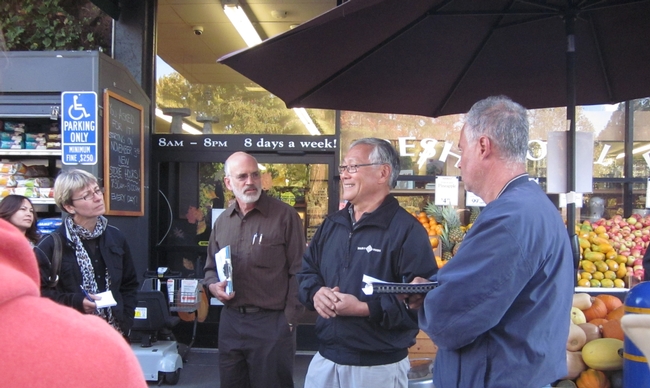
Bill Fujimoto Diablo Foods (3)
Saving the Monarchs
If you think people don't care about monarch butterflies, think again. A recent survey published in Conservation Letters showed that Americans...
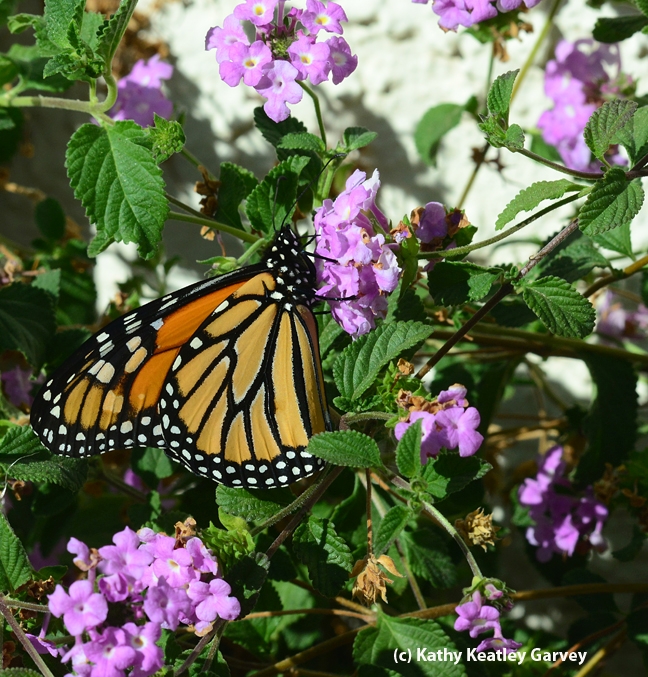
A monarch butterfly on lantana last week in Vacaville, Calif. (Photo by Kathy Keatley Garvey)
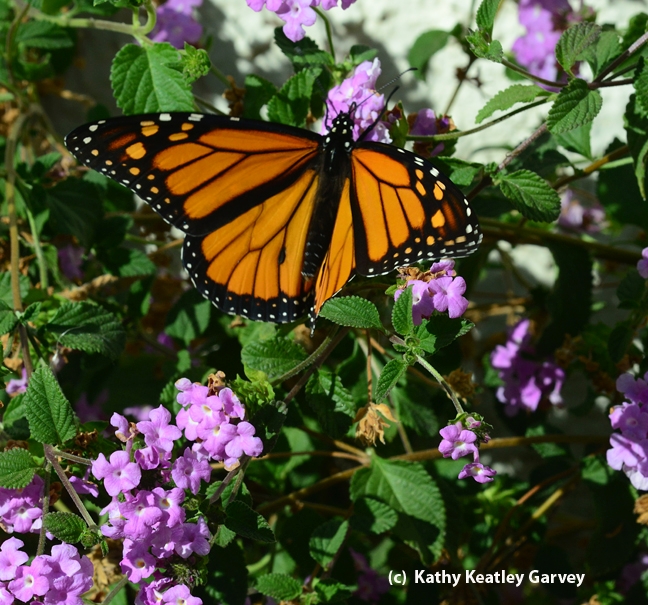
Monarch taking flight. (Photo by Kathy Keatley Garvey)
Snakes in a Tree!
Who knew gopher snakes climb trees? We learned that they could when my husband saw one climb (slither?) up our backyard orange tree.
On a recent afternoon, my husband and daughter discovered a large snake winding its way along a backyard path of our suburban home. The snake apparently tired of having its picture taken and slowly made its escape up our orange tree. Based on the snake’s markings, my husband concluded that it was a California Night Snake, which is described as mildly venomous, but not dangerous to humans. You can imagine my surprise when I was told that we had a venomous tree snake in our backyard! On further research and consultation with the California Academy of Sciences’ Herpetology Department, however, we learned that our snake was merely a “garden-variety” gopher snake.
I am used to see gopher snakes out in the field, but not in a truly suburban environment. Since then, however, I have learned that gopher snakes one of the more common snakes in California. They are often seen around human dwellings, including suburban backyards, because they are attracted to rodents in the area.
Wait. Attracted to rodents? What rodents?! Alas, within two days, we found out when we spotted a rat raiding our bird feeder. Ugh. Now we have given up filling our bird feeders (which I miss quite a bit) and are trying to be better about picking up fallen fruit, and we are rooting for our tree-climbing gopher snake to do its job. Even though we haven’t seen the snake since that one day, we can’t persuade our children to pick oranges anymore!
References:
http://www.saczoo.org/document.doc?id=356
http://www.californiaherps.com/identification/snakesid/gophersnakes.id.html
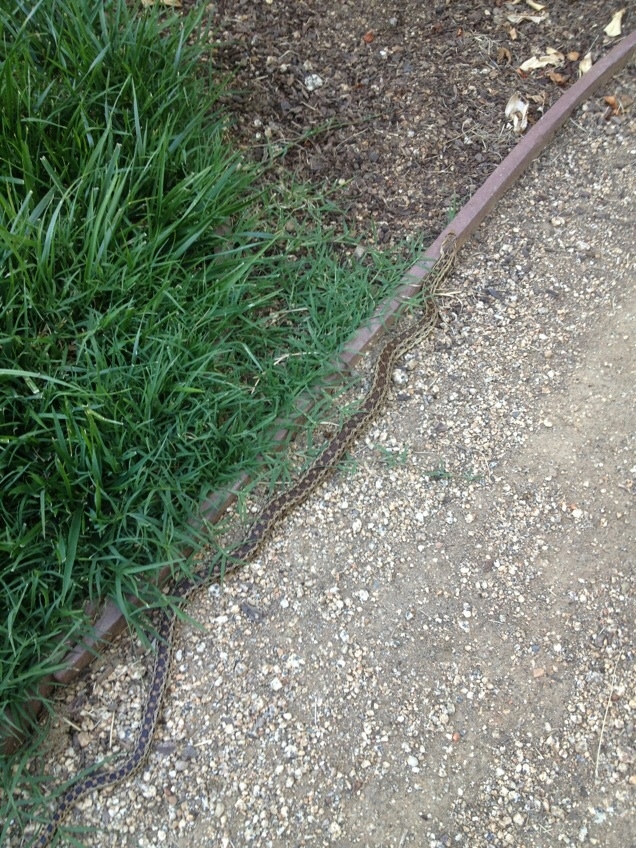
Gopher snake (photos by Erin Mahaney)
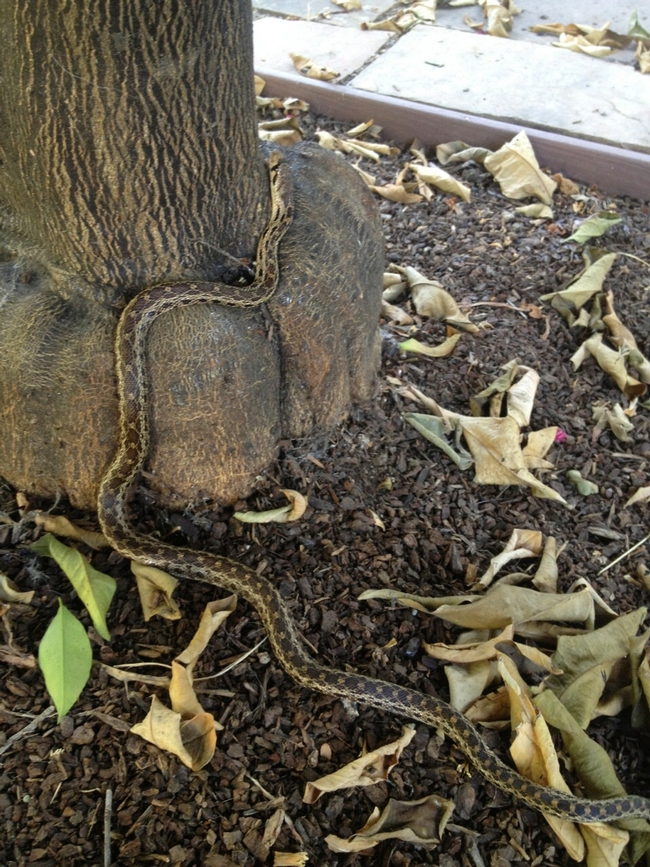
Snake making its way onto the tree.
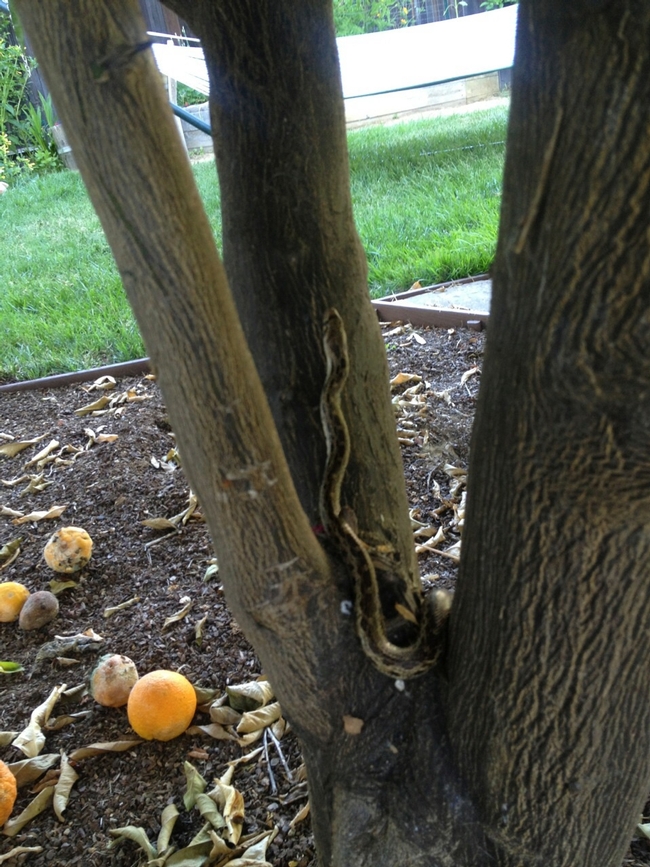
image

